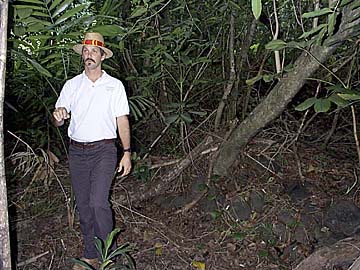


Chipper Wichman, director of Limahuli Garden, inspects
ancient taro terraces. He plans to restore the terraces,
with work starting this year.
Ancient
‘breadbasket’ to
be restored
Taro terraces at Haena,
By Anthony Sommer
Kauai, will be a living exhibit
of Hawaii culture
Star-BulletinHAENA, Kauai -- The high rain forest canopy blocks out much of the sunlight and the thick undergrowth tangles around your feet, and you have to stop swatting mosquitoes long enough to look carefully for what's hidden here.
If you don't see it, Chipper Wichman will point it out: A wall of carefully piled black volcanic rocks hidden in the brush, then a level open space, then another row of rocks.
What you're looking at are loi kalo, ancient irrigated taro terraces covered over by nature but untouched by development.
According to radioactive carbon-dating of artifacts found elsewhere in the area, Hawaiians built this intricate agricultural system at least 700 years ago. The terraces in the Haena area remained in at least partial use until the middle of this century, when killer tsunamis in 1946 and 1957 persuaded the last remaining farmers to abandon the low-lying area.
Wichman is director of the Limahuli Garden of the National Tropical Botanical Garden directly across Kuhio Highway from the abandoned taro terraces.
It's his plan to restore the ancient terraces to what he calls a "living exhibit that will perpetuate the Hawaiian culture." Work is scheduled to begin later this year, with completion about two years away.
The Limahuli Loi Restoration Project is receiving strong support. The state Office of Environmental Quality Control, which is circulating an environmental assessment for comment through April 22, has stated: "Impacts resulting from the proposed action will be almost exclusively positive."
Wichman and his family have been in the restoration business in Limahuli Valley near the end of the road on Kauai's North Shore for more than three decades.
Wichman's grandmother, Juliet Rice Wichman, was a shareholder in the Haena Hui, and when the land was partitioned in 1967, she asked that her portion be consolidated into the 1,000 acres that make up virtually the entire valley.
Haena is one of the longest continuously inhabited areas in Hawaii, with artifacts found dating back 1,500 years.
Juliet Rice Wichman gave the 13 acres that include the existing garden to the National Tropical Botanical Garden, a private nonprofit corporation chartered by Congress, in 1976. It was opened to the public in 1995 and in 1997 was named the best botanical garden in the United States by the American Horticulture Society.
In 1994, Chipper Wichman donated the remaining 985 acres of the valley to the National Tropical Botanical Garden. Located mauka of the garden and much of it accessible only by helicopter, the upper valley is being cleared of alien plants.
At about the same time, Wichman began eyeing the ancient taro terraces makai of the garden on two parcels of privately-owned land totaling 3.7 acres.
In 1994, Molly Moore, who has a home adjacent to the property, donated one of the parcels to the National Tropical Botanical Garden.
Shortly afterward, her daughter, Polly Moore Walters, turned down what Wichman terms "a very handsome offer" from a private buyer for the other parcel. She then sold the property at 20 percent below appraised value to the Kauai Public Land Trust, which transferred it to National Tropical Botanical Garden.
The overgrown property is in stark contrast to the manicured Limahuli Garden across the highway.
But when Wichman walks through it, his eyes see it as it was in the past and as it will be again in the very near future.
"Literally, this was once a breadbasket for the island," Wichman says.
The area was capable of producing far more taro than the local inhabitants could use, and it possibly was exported to other areas of Kauai and Niihau, Wichman believes.
He said: "In the Hawaiian way, a group from Limahuli might take taro to people on Niihau as a gift. And the people on Niihau might give them, say, woven mats as a gift."
The restoration will focus on preserving archaeological resources.
The ancient irrigation system will be painstakingly re-created by hand: Water was diverted from the stream into the highest terrace and routed into the lower terraces before being returned to the stream.
"We want to create a model for restoring loi in other areas," Wichman said.
One of the most promising areas is right next door at Haena State Park where 17 acres of ancient terraces exist, he said.